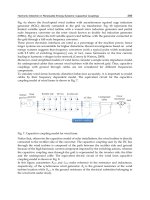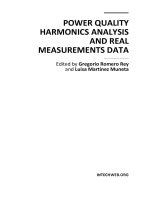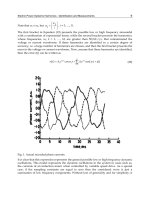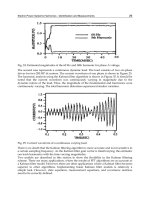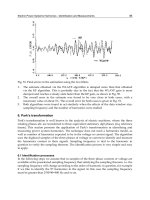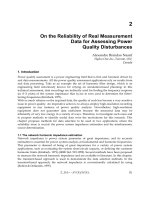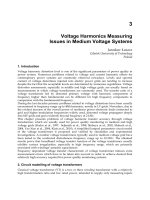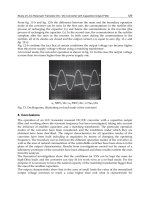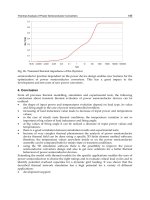Power Quality Monitoring Analysis and Enhancement Part 12 pot
Bạn đang xem bản rút gọn của tài liệu. Xem và tải ngay bản đầy đủ của tài liệu tại đây (5.84 MB, 25 trang )
Power Quality – Monitoring, Analysis and Enhancement
262
• Has a low dependency of the THD on the high harmonic orders in the high modulation
index.
• Reduces the size of the filter inductance ()
f
L . This is because the order of the low order
harmonic (LOH) increases
• Creates the minimum power and switching losses in the 50% and 100% modulation
index interval, respectively
• Produces the maximum number of levels in the line or phase voltage
• Provides rapid damping of the distortion factor (DF) of the line and the phase voltage
versus the switching frequency. Because of this rapid damping, DF is independent of
the switching frequency
• Reduces the transient time for one cycle period to obtain a sinusoidal voltage and load
current
a
T5.0
64c
C
44c
C
c
T
b
T
64b
C
64a
C
44b
C
44a
C
24c
C
24b
C
24a
C
a
T
b
T
c
T
a
T5.0
a
T5.0
52c
C
32c
C
b
T
c
T
52b
C
52a
C
32b
C
32a
C
12c
C
12b
C
12a
C
a
T
c
T
b
T
a
T5.0
a
T5.0
62c
C
42c
C
c
T
b
T
62b
C
62a
C
42b
C
42a
C
22c
C
22b
C
22a
C
a
T
b
T
c
T
a
T5.0
a
T5.0
54c
C
34c
C
b
T
c
T
54b
C
54a
C
34b
C
34a
C
14c
C
14b
C
14a
C
a
T
c
T
b
T
a
T5.0
a
T5.0
53c
C
33c
C
c
T5.0
b
T
53b
C
53a
C
33b
C
33a
C
13c
C
13b
C
13a
C
a
T5.0
c
T
a
T5.0
b
T
c
T5.0
a
T5.0
c
T5.0
63c
C
43c
C
a
T5.0
b
T
63b
C
63a
C
43b
C
43a
C
23c
C
23b
C
23a
C
c
T5.0
a
T
c
T5.0
b
T
a
T5.0
c
T5.0
Compensation of Reactive Power and Sag Voltage
Using Superconducting Magnetic Energy Storage System
263
Table 3. The implemented switching strategy in the three-level NPC inverter with Space
Vector Pulse Width Modulation
3. A novel switching strategy for the two-quadrant three-level chopper
As was previously discussed, the SMES control methods for stabilizing capacitors voltage
depends upon the power networks. In the first control approach, the transmitted active and
reactive power to the network is controlled by a NPC voltage source inverter, while the
capacitors voltage is stabilized using a chopper. This approach is used to investigate the
interaction between the SMES and the power networks. This control approach is easily
implemented if an optimized and appropriate switching strategy for the chopper is defined;
5 shows a two-quadrant three-level chopper that was studied in this work.
In Table 4, all possible switching states in the three-level chopper as well as the SMES coil
current path are provided. One of the main requirements for the switching strategy of the
multi-level choppers is to minimize both the switching losses and the frequency in order to
eliminate the need for high frequency electronic switches. Moreover, minimization of the
power loss is obtained by minimizing the number of on-switches with the minimum on-
time in each switching period. Therefore, the switching states in which each chopper
switching period creates the minimum number of displacements in the switching states are
selected as the best states for the SMES coil charge and discharge modes. The optimum
switching states are highlighted in Table 4; other switching states that do not satisfy the
aforementioned conditions were not used [28].
Power Quality – Monitoring, Analysis and Enhancement
264
Current path
1212
(,,,)
′′
dddd
SSSS
load
V
Mode
1212
,,,
′′
dddd
SSSS
(1111)
12
+
CC
VV
FCM
12 2
,,,
′′
dd dd
SSDS
(0111)
2C
V
12
,,,
′′
dddd
SDDS
(0110)
0
112
,,,
′′
dddd
SDSS
(1110)
1C
V
CM
,
′
ee
DD
(0000)
12
−−
CC
VV
FDM
1
,,
′′′
dde
SDD
(0010)
2
−
C
V
12
,,,
′′
dddd
SDDS
(0110)
0
2
,,
edd
DDS
(0100)
1
−
C
V
DM
12
,,
ed d
DS S
(1100)
0
12
,,
ed d
DS S
(1101)
0
12
,,
′′ ′
dd e
SSD
(1011)
0
12
,,
′′ ′
dd e
SSD
(0011)
0
2
,,
edd
DDS
(0101)
1
−
C
V
,
′
ee
DD
(1010)
12
−−
CC
VV
,
′
ee
DD
(1001)
12
−−
CC
VV
,
′
ee
DD
(1000)
12
−−
CC
VV
,
′
ee
DD
(0001)
12
−−
CC
VV
Unusable
Table 4. Switching states in a two-quadrant three-level chopper
Another requirement in the switching strategy of the multi-level choppers is the
independent action of the capacitors voltage controllers. The switching strategy that satisfies
the two cited requirements is outlined in Table 5. The charge and discharge modes (CM and
DM) in Table 5 are obtained from the proper states in Table 4, assuming that the chopper
switching period is 2
ch
T .
Note that
o
T and
u
T are, respectively, the operation times that the voltage of the upper and
lower capacitors are connected to the positive and the negative polarities of the load during
the charge and the discharge modes. Also,
z
T is the chopper operation time when the load is
short circuit; this occurs at both the charge and discharge modes. Hence, the duty cycles of
the chopper can be defined as follows:
2, 2, 2==++=
o o ch u u ch o u z ch
dTTdTTTTT T (13)
From this equation, it can be seen that
,,
ou
ddand
z
d vary within the range [0, 1]. Also,
Table 5 shows that in the charge and the discharge modes, +
ou
dd is always less than one,
which means that the required time for compensating the capacitor voltage to the reference
voltage is less than a single switching period of the chopper. In other words, if +
ou
dd is
more than one, the required time for the compensation of the capacitors voltage to the
reference voltage will be more than a single switching period of the chopper.
In this case, the compensation of the capacitors voltage to the reference voltage should be
performed simultaneously. The fast charge and discharge (FCM and FDM) modes have
Compensation of Reactive Power and Sag Voltage
Using Superconducting Magnetic Energy Storage System
265
been considered for this case; note that in changing from the fast charge mode to the charge
mode, or from the fast discharge mode to the discharge mode and vice versa, the minimum
number of switch displacements of each chopper switching period occurs, resulting in a
minimum of switching losses presenting an advantage of the proposed switching strategy.
a)
b)
Fig. 5. a) The two-quadrant three-level chopper, b) The load (DC filter and SMES coil)
Table 5. The implemented switching strategy in the two-quadrant three-level chopper
Power Quality – Monitoring, Analysis and Enhancement
266
4. Chopper duty cycle controller design
In this section, a block diagram for generating the duty cycle of CM and FCM is presented
(Fig. 6). To enhance the system dynamic response when balancing the capacitors voltage, it
is necessary to ensure that the capacitors voltages are equal prior to connecting the inverter
to the power network. To achieve this, the voltages of the upper and the lower capacitors are
compared with the reference voltage, which is assumed to be 0.5
dc
V , as seen in Fig. 6.
Subsequently, the difference in the voltages is passed through the limiters with [0 0.5]
interval. These limiters work so that each capacitor is charged for only 50% of the switching
period; in fact, the outputs of these limiters can only produce the charge mode (CM). After
connecting the inverter to the power network, the PI controllers begin operating and the
voltage errors are fed to these controllers. Using the signal holders, the outputs of the PI
controllers are sampled every 2
ch
T period. The signal holders with a 2
ch
T sampling time are
used to avoid abrupt variations in the duty cycles. If the duty cycles vary abruptly, the turn
on/off times should be zero, but this is practically impossible. The signal holder outputs are
passed through the limiters with [0 1] interval; these limiters can produce both the charge
and the fast charge modes (CM, FCM).
a) b)
Fig. 6. The chopper duty cycle controller
With the availability of
,,
ou
dd
ch
T , and by using the Embedded MATLAB Functions shown
in Fig. 6, the various modes of the chopper (CM, FCM, DM, and FDM) can be determined.
Finally using these modes, the corresponding switching strategies are applied to the
chopper switches based on Table 5.
5. Simulation results of the switching strategy of the three-level chopper
In this section, the strategies presented in sections 2 through 4 are simulated using
MATLAB®
software. The power network to which the SMES is connected is shown in Fig. 7
and was modeled using the M-file in MATLAB®. The power network and the SMES
parameters are given in Appendix I.
In Fig. 8, the SMES performance using the developed approaches is compared with that of
the SMES when the capacitors of the three-level NPC inverter are replaced with equal and
ideal voltage sources (SMES with ideal VSI). These comparisons are from the perspective of
the THD and the DF of the inverter output line voltage. As seen in this figure, the
Compensation of Reactive Power and Sag Voltage
Using Superconducting Magnetic Energy Storage System
267
performance of the SMES using the chopper duty cycle controller is the same as that of the
SMES with an ideal VSI.
Fig. 7. The power network
Fig. 8. THD and DF variation of the inverter output line voltage
Power Quality – Monitoring, Analysis and Enhancement
268
Fig. 9 shows the voltage variation of the capacitors versus the modulation index; this figure
indicates that the proposed schemes are capable of stabilizing the capacitors voltage to the
reference voltage (with less than 0.5% error in the worst case scenario). The smallest voltage
variation (with 0.0625% error) is obtained when the modulation index is 0.65, as shown in
Figure 9. This is because PI controllers have been regulated for this modulation index; in
short, the variation of the capacitor voltage depends on both the modulation index and the
parameters of the PI controllers. Therefore, in order to obtain the best results, it is recommended
that the parameters of the PI controllers be deregulated for each modulation index.
Fig. 9. The capacitors voltage variation versus index modulation
Fig. 10. The current and the voltage of the SMES coil and the current of the load
Compensation of Reactive Power and Sag Voltage
Using Superconducting Magnetic Energy Storage System
269
Fig. 10 shows the voltage and current of the SMES coil and the current of the load. From this
figure, it can be seen that the current of the SMES coil is decreasing, or rather, that the stored
energy in the coil is discharging. The discharged energy is transmitted to the chopper in the
active power form because in this transmission, the current of the load and the voltage of the
SMES coil remain constant.
a)
b)
Fig. 11. a) The voltage of the capacitor
fdc
C
and the chopper duty cycle percent,
b) Steady state duty cycle percent
Fig. 11 depicts the variation of the chopper duty cycle and the voltage of the DC filter
capacitor. In this figure, the inverter is connected to the power network at
0.08 [sec]=t . It is
concluded from this figure that before
0.08 [sec]=t , the CM mode has been selected by the
Power Quality – Monitoring, Analysis and Enhancement
270
Embedded MATLAB function, and after this time, both the CM and the FCM modes have
been selected as well. Also, as observed in Fig. 11a, the voltage of the
fdc
C is important in
stabilizing the voltage of the SMES coil; Fig. 11b shows that in steady state condition, only
the CM mode occurs for this power network.
Fig. 12 shows the voltage variation of the capacitors; the initial voltages of the capacitors
1
C
and
2
C were 9800 [ ]V and 9500 [ ]V , respectively. As noticed in Fig. 12, the proposed
switching strategy properly stabilizes the capacitors voltage before and after connecting the
inverter to the power net-work. In Fig. 12, the voltage variations of the capacitors in the
steady state condition, as can be verified in Fig. 9, is less than
6.25 [ ]V (0.062%) Compared
with the values defined in the IEEE standard specifications and obtained in [27] (i.e. 1% ),
this value has been reduced approximately 15 times.
Fig. 12. Variation of the voltage of the capacitors
1
C and
2
C
The parameters of the PI controllers, as seen in Appendix I, should be independently tuned
for the upper and lower capacitors. This is because when using the SVPWM, the upper and
the lower capacitors are not discharged at the same rate; consequently, the number of the PI
controllers should be equal to that of the level of the inverters, and the parameters of each PI
controller should be independently tuned. In fact, using this approach, the voltage of the
inverter capacitors can be stabilized even when the power network is asymmetric and
unbalanced. To verify the simulation results obtained by the proposed switching strategy
given in Tables 3 and 4, part of the implemented switching strategy in the inverter and the
three-level chopper are shown in Figs. 13 and 14, respectively. These figures show that the
carrier waves of the chopper and the inverter are triangular, that the period of these carrier
waves for the inverter and the chopper are
2 0.001[sec]=
S
T and 2 0.001 [sec]=
ch
T , and that
their magnitudes are
S
T and
ch
T , respectively.
In Fig. 15, the steady state line voltage and the current of loads 2 and 3 are shown. Fig. 16
shows the steady state line voltage and the current of the inverter prior to filtering.
Compensation of Reactive Power and Sag Voltage
Using Superconducting Magnetic Energy Storage System
271
Comparisons of Figs. 15 and 16 show that the AC passive filter successfully filters out
the current and the voltage harmonics that are produced by the inverter at the load
terminals.
Fig. 13. Part of the proposed switching strategy for the inverter using the SVPWM
Fig. 14. Part of the proposed switching strategy for the three-level chopper
Power Quality – Monitoring, Analysis and Enhancement
272
0.35 0.355 0.36 0.365 0.37 0.375 0.38 0.385 0.39 0.395 0.4
-2
-1
0
1
2
V
line
[KV]
Modulation index = 0.65 & Number of Load = 2
0.35 0.355 0.36 0.365 0.37 0.375 0.38 0.385 0.39 0.395 0.4
-2
-1
0
1
2
I
line
[KA]
Time [sec]
a)
0.35 0.355 0.36 0.365 0.37 0.375 0.38 0.385 0.39 0.395 0.4
-2
-1
0
1
2
V
line
[KV]
Modulation index = 0.65 & Number of Load = 3
0.35 0.355 0.36 0.365 0.37 0.375 0.38 0.385 0.39 0.395 0.4
-3
-2
-1
0
1
2
3
I
line
[KA]
Time [sec]
b)
Fig. 15. Steady state line voltage and the current of the loads: a) No.2, b) No.3.
Compensation of Reactive Power and Sag Voltage
Using Superconducting Magnetic Energy Storage System
273
0.35 0.355 0.36 0.365 0.37 0.375 0.38 0.385 0.39 0.395 0.4
-30
-20
-10
0
10
20
30
V
line
[KV]
Modulation index = 0.65 & voltage and current of inverter
0.35 0.355 0.36 0.365 0.37 0.375 0.38 0.385 0.39 0.395 0.4
-4
-2
0
2
4
I
line
[KA]
Time [sec]
Fig. 16. The steady state output voltage and the current of the inverter
6. Voltage sag compensation algorithm
Here, a new algorithm is presented to compensate the sag voltage in an R-L load using
SMES. Fig. 17 shows the configuration of the studied power network, the R-L loads, and the
SMES.
Fig. 17. Configuration of the R-L load, the SMES, and the power network
To compensate the voltage sag using SMES, it is necessary that the proper values of
a
m and
inv
ϕ
be calculated and applied to the inverter. If the phasor voltage of the R-L load 2
Power Quality – Monitoring, Analysis and Enhancement
274
(resulting only from the generator) before and after the voltage sag is shown by
p
v and
n
v ,
respectively, and the phasor voltage of this R-L load (resulting only from connecting the
SMES to the power network) after the voltage sag is shown by ,
smes
v then the phasor
diagram of the R-L load voltage can be shown as given in Fig. 18, using which, the following
equations can be obtained:
1
sin sin
tan
cos cos
−
−
=
−
ppnn
smes
ppnn
g
νϕνϕ
ϕ
νϕ
ν
ϕ
(14)
()
cos cos cos=−
smes
pp
n n smes
ννϕνϕ ϕ
(15)
By calculating
smes
ϕ
and
smes
v from (14) and (15), and by using the power flow that considers
only the effect of the SMES system, the values of the
a
m and
inv
ϕ
for applying to the three-
level NPC inverter can be calculated.
Fig. 18. The phasor diagram of the voltage sag compensation in the R-L load
7. Simulation rsults and dscussion
The power network shown in Fig. 17 was simulated using MATLAB software; the
parameters used in this figure are the same as those defined in Fig. 7, and the parameters for
the generators are provided in Appendix I; in addition, the sag compensation of the voltage
for load 2 using the SMES is shown in Fig. 19. In this study, the voltage of the generator
drops to
0.5 [ . .]
p
u ; in Fig. 19a, the voltage immediately decreases at 0.5=t [sec] from its full
value to the sag value in essentially zero time, while in Fig. 19b, the same observation occurs
during one cycle in ramp rate. In Figs. 19a and b, the Compensator begins sampling the
magnitude and phase of the voltage of load 2 after one cycle and again after three cycles of
voltage sag, respectively. As can be seen in this figure, the SMES successfully uses the
proposed algorithm and compensates the load voltage in less than one cycle. Performance
comparison shows that the dynamic response time of the SMES using the proposed
algorithm when compensating for the voltage sag is 5 times faster than that which is
presented in [32], and is equal to the responses obtained by the current source inverter (CSI)
SMES presented in [33]-[36].
To study the active and reactive powers at steady state, in all other figures that are
presented in this section, the Compensator is regulated to begin measuring and compensating
after three cycles of the voltage sag. Fig. 20 shows the compensation of the phase and the
Compensation of Reactive Power and Sag Voltage
Using Superconducting Magnetic Energy Storage System
275
magnitude of the voltage of load 2. As seen in this figure, the SMES uses the presented
algorithm to successfully compensate both the magnitude and the phase of the load voltage
and return them to their initial values. In Fig. 20, the voltage variation of the load in steady
state condition is approximately
1.1559 [ ](0.0365%)V , which is 136 times less than the IEEE-
519 standard
(5%).
a)
b)
Fig. 19. The voltage sag compensation of the load No. 2
Power Quality – Monitoring, Analysis and Enhancement
276
Fig. 20. Compensation of the phase and magnitude of the voltage of the load No. 2.
8. Conclusion
In this study an appropriate switching strategy for the NPC VSI with several advantages for
the SMES regarding its ability to improve the performance of this device was presented.
Some advantages of using this strategy for the NPC VSI presented in this chapter include:
•
Optimizing power quality by implementing a proper switching strategy in SVPWM for
VSI SMES
•
Better stabilization of the capacitors voltage of the VSI SMES than that of the IEEE
standard
•
Implementing the rapid charge and discharge modes as opposed to the charge and
discharge modes in order to increase the dynamic response time when stabilizing the
capacitors voltage of the VSI SMES
•
Independent control of the capacitors voltage in the VSI SMES for compensating
asymmetric and unbalanced loads
•
Minimizing the switching and power losses, resulting in easy and reliable convection
from multi-level converter’s switches
•
Using the proposed switching strategies, resulting in the power quality becoming equal
with the case in which the capacitors of the inverter are replaced with an ideal and
equivalent voltage source (SMES with ideal VSI)
•
Effective and highly reliable performance of the presented strategy when used with a PI
control approach
•
Compensating capacitors voltage of the VSI SMES prior to connecting the SMES to the
power network (stand-by mode)
•
Furthermore, an algorithm was presented for the VSI SMES in order to compensate the
voltage sag. Some advantages of the proposed algorithm include:
•
Compensating the voltage sag and the voltage phase of the load in less than one cycle
Compensation of Reactive Power and Sag Voltage
Using Superconducting Magnetic Energy Storage System
277
• Compensating the active and the reactive power in less than four cycles
•
Load voltage stabilizing in good agreement with the IEEE-519 standard
9. Appendix I
The parameters of the PI controllers:
0.1, 0.1, 0.04, 0.03=== =
OO U U
KP KI KP KI
Specifications of the transmission line
:
11 2
233
15[], 1.5[], 15[],
1.5 [ ], 30[ ], 3[ ]
=Ω = Ω =Ω
=Ω =Ω =Ω
LL L
LLL
XR X
RXR
Specifications of the synchronous generator
:
0.15 [ . .], 0.015 [ . .],
20 [ ], 50 [ ]
==
==
GG
GG
XpuR pu
VKVSMVA
Specifications of the transformers
:
11 1
122
21 3
33 3
0.1 [ . .], 0.01 [ . .], 30 [ ],
20 /132 [ ], 0.1 [ . .], 0.01 [ . .],
30 [ ], 132 /20 [ ], 0.1[ . .],
0.01 [ . .], 50 [ ], 132 /13.2 [ ]
== =
===
== =
== =
TT T
TTT
TT T
TT T
XpuR puSMVA
VKVXpuRpu
SMVAV KVX pu
R
p
uS MVAV KV
Specifications of the R-L loads
:
111
12 2
223
33 1
2 [ ], 5 [ ], 30 [ ],
18 [ ], 0.2 [ ], 0.5 [ ],
30 [ ], 18 [ ], 0.2 [ ],
0.5 [ ], 50 [ ], 13.2 [ ]
==Ω=
== =Ω
===
=Ω = =
RL RL RL
RL RL RL
RL RL RL
RL RL RL
LmHR S MVA
VKVL mHR
SMVAVKVL mH
RSMVAVKV
Assumed specifications of the NPC VSI and the SMES
:
:,0.75[],1.1[],
0.05 [ ], 20 [ ], 2 [ ], 400 [ ]
=Ω=
====
IGBT FO
Sdcchf
IGBT SEMIKRONSKM R m V V
PWVKVfKHzC F
μ
2
1
800 [ ], 1[ ], 20 [ ], 0.65,
50 [ ], 10 [ ], 2 [ ], 200 [ ]
700 [ ], 2 [ ], 2 [ ], 200 [ ]
===Ω=
===Ω=
==Ω==
ffdcfdc
SMES SMES
fdc fdc s
LHLmHRmM
f
Hz L H R C mF
CFrfKHzCmF
μ
μ
μ
10. References
[1] S. Massoud Amin, Clark W. Gellings, The North American power delivery system:
Balancing market restructuring and environmental economics with infrastructure
security, Energy, Volume 31, Issues 6-7, May-June 2006, Pages 967-999.
Power Quality – Monitoring, Analysis and Enhancement
278
[2] Z. Xiaoxin, Y. Jun, S. Ruihua, Y. Xiaoyu, L. Yan, T. Haiyan, An overview of power
transmission systems in China, Energy, In Press, Corrected Proof, Available online
12 June 2009.
[3] H. Chao, Global electricity transformation The critical need for integrated market design
and risk management research, Energy, Volume 31, Issues 6-7, May-June 2006,
Pages 923-939.
[4] A. A. Bayod-Rújula, Future development of the electricity systems with distributed
generation, Energy, Volume 34, Issue 3, March 2009, Pages 377-383.
[5] M. R. Qader, Optimal location of advanced static VAR compensator (ASVC) applied to
non-linear load model, Energy, Volume 31, Issue 12, September 2006, Pages 1761-
1768.
[6] A. B. Cambel, F.A. Koomanoff, High-temperature superconductors and CO
2
emissions,
Energy, Volume 14, Issue 6, June 1989, Pages 309-322.
[7] P. Varghese, K. Tam, Structures for superconductive magnetic energy storage, Energy,
Volume 15, Issue 10, October 1990, Pages 873-884.
[8] V. D. Linden, Septimus, Bulk energy storage potential in the USA, current developments
and future prospects, Energy Volume 31, Issue 15, December 2006, Pages 3446-3457.
[9] H. Li, T. L. Baldwin, C. A. Luongo, and D. Zhang, A Multilevel Power Conditioning
System for Superconductive Magnetic Energy Storage, IEEE Trans, Applied
Superconductivity, vol. 15, no. 2, Jun. 2005.
[10] J. Shi, Y. Tang, L. Ren, J. Li, and S. Cheng, Discretization-Based Decoupled State-
Feedback Control for Current Source Power Conditioning System of SMES, IEEE
Trans. Power Del, vol. 23, no. 4, Oct. 2008.
[11] H. Zhang, J. Ren, Y. Zhong, J. Chen, Design and Test of Controller in Power
Conditioning System for Superconducting Magnetic Energy Storage, In Proc. The
7th International Conference on Power Electronics Oct. 22-26, 2007 / Exco, Daegu,
Korea.
[12] D. H. Leea, Power conditioning system for superconductive magnetic energy storage
based on multilevel voltage source converter, Blacksburg, Virginia, July 6, 1999.
[13] S. Nomura, N. Watanabe, C. Suzuki, H. Ajikawa, M. Uyama, S. Kajita, Y. Ohata, H.
Tsutsui, S. Tsuji, R. Shimada, Advanced configuration of superconducting magnetic
energy storage, Energy, Volume 30, Issues 11-12, August-September 2005, Pages
2115-2127.
[14] P. H. Rebut, Perspectives on nuclear fusion, Energy, Volume 18, Issue 10, October 1993,
Pages 1023-1031.
[15] G. Boukettaya, L. Krichen, A. Ouali, A comparative study of three different sensor less
vector control strategies for a Flywheel Energy Storage System, Energy, Volume 35,
Issue 1, January 2010, Pages 132-139.
[16] M. Saxe, A. Folkesson, P. Alvfors, Energy system analysis of the fuel cell buses operated
in the project: Clean Urban Transport for Europe, Energy, Volume 33, Issue 5, May
2008, Pages 689-711.
[17] P. Purkait and R. S. Sriramakavacham, A New Generalized Space Vector Modulation
Algorithm for Neutral point clamped Multi-level Converters, Progress in
Electromagnetic Research Symposium, Cambridge, USA, pp. 26-29, Mar. 2006.
Compensation of Reactive Power and Sag Voltage
Using Superconducting Magnetic Energy Storage System
279
[18] L. G. Franquelo, Simple and Advanced Three dimensional Space Vector Modulation
Algorithm for Four-Leg Multi-level Converters Topology,In 30th Annual Conference
of the IEEE Industrial Electronics Society, Busan, Korea, pp. 2 – 6, Nov. 2004.
[19] K. Zhou and D. Wang, Relationship between Space Vector Modulation and Three-Phase
Carrier-Based PWM A Comprehensive Analysis, IEEE Trans, Industrial Electronics,
vol. 49, no. 1, Feb. 2002.
[20] M. Delos, A. M. Prats, New Space Vector Modulation Algorithms, HAIT Journal of
Science and Engineering B, vol. 2, Issues 5-6, pp. 690-714, 2005.
[21] A. Kwasinski, Time Domain Comparison of Pulse-Width Modulation Schemes, IEEE
Power Electronics Letters, vol. 1, no. 3, Sep. 2003.
[22] T. Bernet, S. Recent, Development of High Power Converters for Industry and Traction
Application, IEEE Trans. on Power Electronics, Vol. 15, Nov. 2000.
[23] M. R. Alizadeh Pahlavani, A. Shoulaie, Comparison
of Space Vector Pulse Width
Modulation Switching Patterns in Three Level Inverter to Approach Power Quality
Factors, in Proc. 23
rd
International Power System Conf, Tehran, Iran, Nov. 2008,
Persian.
[24] M. R. Alizadeh Pahlavani, A. Shoulaie, Switching Pattern
Optimization of Space Vector
Pulse Width Modulation In Two Level Inverters With Different Objective
Functions, in Proc. 22
nd
International Power System Conf, Tehran, Iran, October. 2007,
Persian.
[25] A. K. Gupta, A. M. Khambadkone, A Space Vector PWM Scheme for Multilevel
Inverters Based on Two-Level Space Vector PWM, IEEE Trans, Industrial Electronics,
vol. 53, no. 5, Oct. 2006.
[26] A. K. Gupta, A. M. Khambadkone, A Simple Space Vector PWM Scheme to Operate a
Three-Level NPC Inverter at High Modulation Index Including Overmodulation
Region, With Neutral Point Balancing,IEEE Trans, Industrial Applications, vol 43, no.
3, May/June 2007.
[27] H. Mao, D. Boroyevich and F. C. Lee, Multi-level 2-quadrant boost choppers for
superconducting magnetic energy storage, Conference of the IEEE.1996.
[28] M. R. Alizadeh Pahlavani, H. A. Mohammadpour, A. Shoulaie, A Novel Scheme for
Chopper Switching to Control Three Level Inverter Capacitor Voltage, 17
th
Iranian
Conference on Electrical Engineering (ICEE), Tehran, Iran, IUST, 2009, Persian.
[29] M. H. J. Bollen, Understanding power quality problems-voltage sags and interruptions,
IEEE Pres, 2000.
[30] Recommended practice for the establishment of voltage sag indices, Draft 6, IEEE
P1564, Jan. 2004.
[31] K. H. LaCommare, J. H. Eto, Cost of power interruptions to electricity consumers in the
United States (US), Energy, Volume 31, Issue 12, September 2006, Pages 1845-1855
[32] A. Bra, P. Hofinann, R. Mauro, C. J. Melhorn, An Evaluation of Energy Storage
Techniques for Improving Ride-Through Capability for Sensitive Customers on
Underground Networks, in Proc. 1996 IEEE.
[33] X. Jiang, X. Liu, X. Zhu, Y. He, Z. Cheng, X. Ren, Z. Chen, L. Gou, and X. Huang, A 0.3
MJ SMES Magnet of a Voltage Sag Compensation System, IEEE Trans, Applied
Superconductivity, vol. 14, no. 2, Jun. 2004.
Power Quality – Monitoring, Analysis and Enhancement
280
[34] X. Jiang, X. Zhu, Z. Cheng, X. Ren, and Y. He, A 150 kVA/0.3 MJ SMES Voltage Sag
Compensation System, IEEE Trans, Applied Superconductivity, vol. 15, no. 2, Jun.
2005.
[35] A. Rong Kim, G. Kim, J. H. Kim, M. Hasan Ali, M. Park, I. Yu, H. Kim, S.H. Kim, and K.
Seong, Operational Characteristic of the High Quality Power Conditioner with
SMES, IEEE Trans, Applied Superconductivity, vol. 18, no. 2, Jun. 2008.
[36] M. R. Alizadeh Pahlavani, H. A. Mohammadpour, A. Shoulaie, Voltage Stabilization of
VSI SMES Capacitors and Voltage Sag Compensation by SMES Using Novel and
Optimized Switching Strategies, in Proc. 24
th
Int. International Power System Conf,
Tehran, Iran, no. 98-F-PQA-0110 , Nov. 2009.
13
Optimal Location and Control of Flexible Three
Phase Shunt FACTS to Enhance Power Quality
in Unbalanced Electrical Network
Belkacem Mahdad
Department of Electrical Engineering, Biskra University
Algeria
1. Introduction
The problem of voltage or current unbalance is gaining more attention recently with the
increasing awareness on power quality. Excessive unbalance among the phase voltages or
currents of a three phase power system has always been a concern to expert power
engineers. An unbalanced voltage supply can cause power electronic converters to generate
more harmonic distortions. It may result in the malfunction of sensitive three-phase
electronic equipment. In fact, the voltage and current unbalance has been regarded as one of
the basic power quality attributes (Birt et al., 1976).
The asymmetry in transmission lines and loads produces a certain degree of unbalance in
real power systems. Under these conditions, low quantities of negative and zero sequence
voltages can be observed in power networks. These magnitudes are considered to be a
disturbance whose level must be controlled by power quality standards to maintain the
electromagnetic compatibility of the system (Mamdouh Abdel-Akher et.al, 2005).
In order to cope with these kind of problems and increase usable power transmission
capacity, Flexible AC transmission systems (FACTS), where developed and introduced to
the market. FACTS philosophy was first introduced by Hingorani (Hingorani, N.G, 1988)
from the Electric power research institute (EPRI). The objective of FACTS devices is to bring
a system under control and to transmit power as ordered by the control centers, it also
allows increasing the usable transmission capacity to its thermal limits. With FACTS devices
we can control the phase angle, the voltage magnitude at chosen buses and/or line
impedances (Mahdad.b et al., 2006)
In practical installation of FACTS in power system, there are six common requirements as
follows (Mahdad.b et al., 2007) :
1. What Kinds of FACTS devices should be installed?
2. Where in the system should be placed?
3. How much capacity should it have?
4. How to coordinate dynamically the interaction between multiple FACTS and the
network to better exploit FACTS devices?
5. How to estimate economically the optimal size and number of FACTS to be installed in
a practical network?
6. How to adjust dynamically the three phase recative power in unbalanced network?
Power Quality – Monitoring, Analysis and Enhancement
282
Recent developments and research indicate clearly that artificial intelligence techniques like
fuzzy logic (Tmsovic, 1992), (Su, C. T. et al., 1996), Artificial Neural Network (Scala et al.,
1996), and expert system (Bansilal et al., 1997) may be useful for assisting experienced
planning engineers in energy centre dispatch. In recent years many interesting applications
of fuzzy systems to reactive power planning and voltage control have been developed and
applied in practical power system distribution. (Udupa et al., 1999) presented approach
based in fuzzy set theory for reactive power control with purpose to improve voltage
stability of power system. (Su et al., 1996) presented a knowledge-based system for
supervision and control of regional voltage profile and security using fuzzy logic.
In the literature, many applications for optimal placement and control of FACTS devices are
developed using the positive-sequence power systems. The application of these methods for
unbalanced power systems may be unrealistic and could not be able to characterize
accurately the real behaviour of the unbalanced distribution system.
One of the main tasks of a planning engineers in electricity distribution system is to ensure
that network parameters, such as bus voltages, and line load, are maintained within
predefined limits (desired value). This chapter tries to give answers to the following
important questions:
• How an experienced planning engineers can choose effeciently locations and
coordination of multiple shunt FACTS devices (SVC, STATCOM) in unbalanced
practical network which are probably high suitable?
• How they can exploit efficiently the performance of these devices without violating the
constraints limits?
Static Var Compensator (SVC) is one of the key elements in power system that provides the
opportunity to improve power quality. This chapter presents a methodology that coordinate
the expertise of power system engineer formulated in flexible fuzzy rules to adjust
dynamically the reactive power compensation based three phase model shunt FACTS
controller installed at critical buses. The main taget of this proposed tecnique is to reduce
the asymmetrical voltage and to enhance the system loadability with consideration of
unbalanced electrical network. The proposed approach has been tested on a variety of
electrical network 5-Bus, IEEE 30-Bus. Testing results indicate clearly that the proposed
approach based in asymmetrical compensation reduces the effect of asymmetrical voltage in
distribution power system and improve the indices of power quality.
2. Flexible AC Transmission Systems (FACTS) technology
The objective of FACTS technology is to bring a system under control and to transmit power
as ordered by the control centre, it also allows increasing the usable transmission capacity to
its maximum thermal limits.
The central technology of FACTS involves high power electronics, a variety of thyristor
devices, microelectronics, communications and advanced control centres. Power flow through
an ac line is a function of phase angle, line end voltages and line impedance, and there is little
or no control over any of these variables. The consequences of this lack of fast, reliable control
and stability problems, power flowing through other than the intended lines, the inability to
fully utilize the transmission resources, undesirable Var flows, higher losses, high or low
voltages, cascade tripping and long restoration time. With FACTS devices we can control the
phase angle, the voltage magnitude at chosen buses and/or line impedances. Power flow is
electronically controlled and it flows as ordered by the control centre (Mahdad. B, 2010).
Optimal Location and Control of Flexible Three Phase Shunt FACTS
to Enhance Power Quality in Unbalanced Electrical Network
283
2.1 Basic types of FACTS controllers
In general, FACTS Controllers can be divided into three categories (Hingorani et al., 1999):
• Series Controllers
• Shunt Controllers
• Combined series-series Controllers
2.2 Role of FACTS controllers
The following points summarize the objectives of FACTS devices in power system control
and operation:
• Control of power flow as ordered
• Increase the loading capability of lines to their thermal capabilities
• Increase the reliability and system security through raising the transient stability limit,
limiting short-circuit currents and overloads, managing cascading blackouts
• Provide greater flexibility in sitting new generation
• Reduce reactive power flows, thus allowing the lines to carry more active power
• Reduce loop flows.
• Enhance the economic dispatch of generating units.
2.3 Three phase static var compensator modelling
Model presented by (Acha et.al, 2004), is based on the concept of a variable susceptance
pq
k
B ,
which adjust itself in order to constrain the nodal voltage magnitude. This changing
susceptance represents the total equivalent susceptance of all modules making up the SVC,
independently of their operating mode and electric characteristics. Based on Fig. 1, the SVC
transfer admittance equation expressed as follows:
a
k
a
k
V θ
b
k
b
k
V θ
c
k
c
k
V θ
ab
c
x
bc
c
x
ac
c
x
ab
L
x
bc
L
x
ac
L
x
q
I±
q
I±
q
I±
Q±
B
ia
, α
B
ib
, α
B
ic
, α
a
k
a
k
V θ
b
k
b
k
V θ
c
k
c
k
V θ
Q±
Q±
Control, α
Fig. 1. SVC based on FC-TCR modules in delta-connected arrangement
+−
=− + −
−− −
aabcaab caa
kkk k kk
bababbcbcb
kkkkkk
ccabcbccac
kkkkkk
IBBB BV
IjB BB B V
IBBBBV
. (1)
Power Quality – Monitoring, Analysis and Enhancement
284
A three-phase SVC model presented by (Acha, et al. 2004) is implemented and adapted
within the proposed algorithm to regulate and control the reactive power injected or
absorbed in the unbalanced three phase power systems. As shown in Fig. 1, every branch
has a fixed capacitor and a thyristor-controlled capacitor reactor. Equation (2) is the
equivalent susceptance or admittance of each branch by controlling the firing delays angles
(α) of thyristor.
V
maxL
I
maxC
I
min
α
max
α
ref
V
L
X
C
X
sl
X
Capacitive Mode
Fig. 2. Typical steady state V-I Characteristics of SVC
()
2sin2−−
=
pq pq
TCR TCR
pq
TCR
pq
TCR
B
L
π αα
πω
(2)
The superscripts p, q correspond to phases a, b and c.
The steady-state control law for the SVC is the typical current-voltage characteristic,
illustrated in Fig. 2.
2.4 Three-phase power flow equation
The network branch modelling in unbalanced multi-wire distribution systems is typically
done and simplified using the Carson’s equations to self and the mutual impedances, and by
applying the kron reduction to determine the reduced impedance matrix Zabc of each
branch, referred to the phases a, b and c.
The power-flow equations at buses k and m based on Fig. 3 may be given by:
() ()
,,,
cos sin ,
==
=−+−
pp jpj pj pj pj
ii i
kk ki k ki k
ikmjabc
PV VG B
θθ θθ
(3)
() ()
,,,
sin sin ,
==
=−−−
pp jpjpjpjpj
ii i
kk ki k ki k
ikmjabc
QV VG B
θθ θθ
(4)
Where the subscript k, m represent the bus number while the subscript p represent the
phase a, b and c.
Optimal Location and Control of Flexible Three Phase Shunt FACTS
to Enhance Power Quality in Unbalanced Electrical Network
285
Z
abc,
Y
abc
a
k
V
b
k
V
c
k
V
a
m
V
b
m
V
c
m
V
R
a
R
b
R
c
L
a
L
b
L
c
Bus k
Bus m
L
ac
L
bc
L
ab
a
k
I
b
k
I
c
k
I
a
m
I
c
m
I
c
m
I
b
k
V
a
k
V
c
k
V
b
m
V
a
m
V
Fig. 3. Representation of a branch reduced to the three-phase branch impedance matrix
The power mismatch equations at buses may be given by:
0Δ=− + =
ppp
kkk
PPdP (5)
0Δ=− + =
ppp
kkk
QQdQ
(6)
Where
p
m
Pd and
p
m
Qd are the active and reactive load powers of phase p at bus m,
respectively.
p
k
P and
p
k
Q , which are given by (3) and (4), are the sum of the active and
reactive power flows of phase p at bus m, respectively.
In the following, the three-phase Newton power flow algorithm in polar coordinates, which
is similar to that proposed in (Acha, et al. 2004), will be described. the non-linear equations
can be combined and expressed in compact form.
()
0=fx (7)
Where,
()
0=fx represents the whole set of power-flow mismatch and machine terminal
constraint equations,
x is the state variable vector and given by
,,,,,,, .
=
t
aabbccaa
xVVVE
θθθδ
(8)
The Newton equation is given by
() ()
Δ=−Jx x
f
x (9)
Where ,
() ()
=∂ ∂Jx
f
xx is the system Jacobian matrix.
The resulting linearised equation, suitable for iterative solutions, becomes:
∂∂
Δ
∂∂
Δ
=
Δ
Δ
∂∂
∂∂
i
pp
i
p
ll
p
i
j
pp
j
p
jj
l
p
jp
pp
l
p
ll
p
j
pp
jj
PP
V
V
P
V
Q
V
V
V
θ
θ
θ
(10)
Where l=k, m, j=k, m and (i) is the iteration number.
Power Quality – Monitoring, Analysis and Enhancement
286
3. Dynamic strategy for asymetric control of multiple shunt compensator
One of the principal tasks of the operator of an electricity distribution system is to ensure
that network parameters, such as bus voltages and line load, are maintained within
predefined limits. The problem of system imbalance has considerable effects on power
systems. The effects of zero sequence current on protection relays and negative sequence
current on motors are well known by power engineers (Mahdad.b et al., 2006). However,
others effects such as increasing system loss, decreasing system capacity, and increasing the
inductive coupling between parallel lines or feeders are often overlooked.
a
j
a
j
V θ∠
b
j
b
j
V θ∠
c
j
c
j
V θ∠
Part 1
Part 2
Control, α
Power Flow Index
V, Ploss, Qloss
Control, α
min
B
max
B
min
B
max
B
Data base
Three-Phase
Power Flow
Fig. 4. A global block control strategy
The intensive use of FACTS devices in the emerging electricity market environment
demands more robust and online FACTS control methodologies.
The main objective of this section is to formulate the basic idea behind the proposed
approach.
3.1 Practical experience rules and fuzzy logic
A review of the literature on reactive power compensation in distribution feeders indicates
that the problem of capacitors Allocation has been extensively researched over the past
